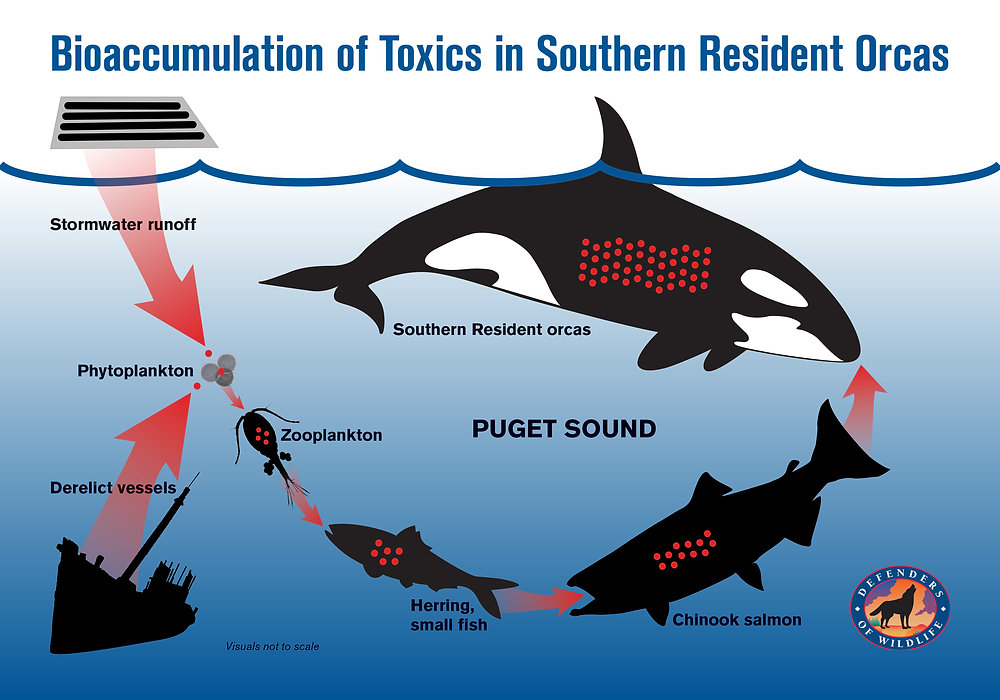Understanding the Impact: Bioaccumulation and Biomagnification

Bioaccumulation and biomagnification are two ecological processes that have significant implications for both the environment and human health. These phenomena occur when certain substances, often harmful chemicals, are taken up by organisms and accumulate within their bodies over time. Understanding the mechanisms and consequences of bioaccumulation and biomagnification is crucial for assessing the risks associated with various pollutants and developing effective strategies for environmental protection.
The Basics of Bioaccumulation

Bioaccumulation refers to the process by which substances, primarily organic pollutants, are absorbed and retained by living organisms. These substances can include pesticides, industrial chemicals, and even heavy metals. When organisms come into contact with these pollutants, they can absorb them through their skin, respiratory system, or digestive tract.
The absorption rate depends on various factors, including the chemical properties of the pollutant, the exposure route, and the physiology of the organism. Some pollutants are readily absorbed and easily penetrate biological membranes, while others are more difficult to uptake.
Once absorbed, the pollutants can accumulate within the organism’s tissues. This accumulation occurs because the rate of uptake often exceeds the rate of excretion or metabolism of the substance. Over time, as the organism continues to be exposed to the pollutant, the concentration of the substance within its body increases, leading to potential health risks.
Biomagnification: The Amplification Effect

Biomagnification, also known as bioamplification or biological magnification, is a process closely related to bioaccumulation. It occurs when the concentration of a substance increases at higher trophic levels in a food chain or food web. In other words, as predators consume prey that have accumulated pollutants, the pollutants become more concentrated in the predators’ bodies.
This amplification effect is particularly concerning because it can lead to the buildup of harmful substances in top predators, which often include humans. For example, consider the case of mercury, a toxic heavy metal. Mercury enters aquatic ecosystems through natural processes and industrial activities. Small aquatic organisms, such as phytoplankton and zooplankton, take up mercury from the water. When these organisms are consumed by small fish, the mercury is transferred to the fish. As larger fish feed on these smaller fish, the mercury accumulates in their tissues. Eventually, when humans consume these fish, they may be exposed to high concentrations of mercury, which can have serious health consequences.
Health Risks and Environmental Impact
The health risks associated with bioaccumulation and biomagnification are significant and varied. Exposure to certain pollutants can lead to acute or chronic illnesses, ranging from minor skin irritations to severe neurological disorders. For example, exposure to high levels of lead can cause neurological damage, particularly in children, affecting their cognitive development and behavior. Similarly, exposure to pesticides through bioaccumulation can lead to various health issues, including endocrine disruption, reproductive problems, and even cancer.
In addition to human health risks, bioaccumulation and biomagnification can have severe ecological impacts. The accumulation of pollutants can disrupt the balance of ecosystems, affecting the survival and reproduction of various species. It can also lead to the extinction of sensitive species, altering the biodiversity of entire regions.
Case Study: DDT and Biomagnification
One of the most well-known examples of biomagnification is the case of DDT (dichlorodiphenyltrichloroethane), a pesticide widely used in the mid-20th century. DDT was initially hailed as a miracle chemical for its effectiveness in controlling insect pests. However, its impact on the environment and wildlife became evident over time.
DDT was found to bioaccumulate in the tissues of various organisms, including fish, birds, and mammals. As DDT moved up the food chain, it became increasingly concentrated. One of the most famous victims of DDT biomagnification was the bald eagle, the national bird of the United States. DDT caused thinning of the eggshells in bald eagles, leading to a dramatic decline in their population. This decline served as a wake-up call, leading to the eventual ban of DDT in many countries.
Mitigation and Prevention Strategies

Addressing the issues of bioaccumulation and biomagnification requires a multi-faceted approach. Here are some key strategies:
Regulation and Enforcement: Strict regulations on the use and disposal of harmful chemicals can help prevent pollutants from entering ecosystems. Effective enforcement of these regulations is crucial to ensure compliance.
Source Control: Identifying and controlling the sources of pollutants is essential. This includes reducing industrial emissions, implementing proper waste management practices, and promoting sustainable agricultural methods.
Monitoring and Early Detection: Regular monitoring of ecosystems and wildlife can help detect the presence of pollutants and their accumulation early on. This allows for timely intervention and the implementation of mitigation measures.
Public Awareness and Education: Educating the public about the risks associated with bioaccumulation and biomagnification can lead to more responsible consumer choices and behaviors.
Alternative Technologies: Investing in and promoting the development of alternative technologies that are less harmful to the environment can help reduce the use of toxic chemicals.
Conclusion
Bioaccumulation and biomagnification are silent but potent processes that highlight the interconnectedness of ecosystems and the potential risks associated with human activities. By understanding these processes and their impacts, we can work towards developing sustainable practices and protecting both the environment and human health.
The implications of bioaccumulation and biomagnification extend far beyond individual organisms, affecting entire ecosystems and human populations. Recognizing these impacts and taking proactive measures is essential for a healthier and more sustainable future.
What are the main differences between bioaccumulation and biomagnification?
+Bioaccumulation refers to the accumulation of substances within individual organisms, while biomagnification describes the amplification of these substances as they move up the food chain. Bioaccumulation occurs within an organism, whereas biomagnification occurs across multiple organisms in a food chain or web.
How do human activities contribute to bioaccumulation and biomagnification?
+Human activities, such as industrial processes, agriculture, and waste disposal, often release pollutants into the environment. These pollutants can then enter ecosystems and be taken up by organisms, leading to bioaccumulation. As these pollutants move up the food chain through predation, biomagnification occurs.
What are some common pollutants associated with bioaccumulation and biomagnification?
+Common pollutants associated with these processes include pesticides, heavy metals like mercury and lead, persistent organic pollutants (POPs), and industrial chemicals. These substances can persist in the environment and accumulate in living organisms over time.
Can bioaccumulation and biomagnification be reversed?
+Reversing the effects of bioaccumulation and biomagnification is challenging, especially when dealing with persistent pollutants. However, by reducing the release of these pollutants into the environment and implementing effective mitigation strategies, it is possible to prevent further accumulation and minimize the risks to both ecosystems and human health.
What are some real-world examples of the impacts of bioaccumulation and biomagnification?
+Real-world examples include the decline of bald eagles due to DDT biomagnification, the contamination of aquatic ecosystems with mercury, and the health issues associated with lead exposure, particularly in children. These examples highlight the far-reaching consequences of bioaccumulation and biomagnification.



